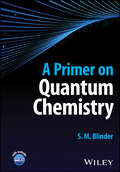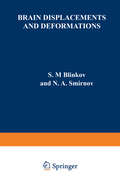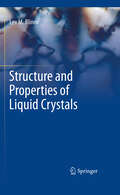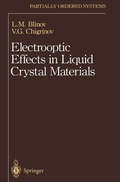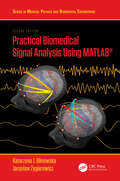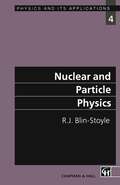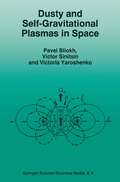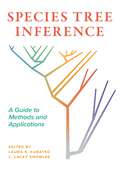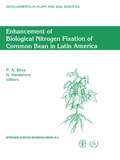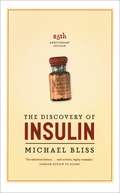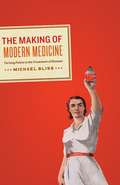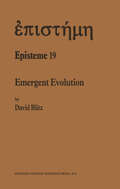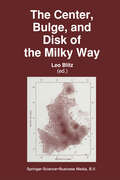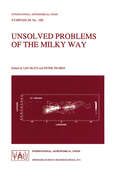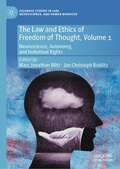- Table View
- List View
A Primer on Quantum Chemistry
by S. M. BlinderA Primer on Quantum Chemistry A practical and accessible guide to the applications of quantum chemistry Quantum chemistry, the branch of physical chemistry which applies quantum mechanical principles to the study of chemical systems, has become an integral part of the study of matter. Concerned with understanding quantum effects at the atomic and molecular level, quantum chemistry underlies an immense range of modern technologies. A Primer on Quantum Chemistry provides a lucid introduction to the difficult mathematical and conceptual foundations of this essential field. It incorporates Mathematica for operations in algebra and calculus, enabling readers to focus on the physical and chemical principles. It thereby equips students with the tools used by professional scientists in applications of quantum chemistry. A Primer on Quantum Chemistry readers will also find: Detailed treatment of subjects including the Schrödinger equation and many more Supplemental online material including problems, solutions, and details of Mathematica computations A carefully developed pedagogical approach that streamlines student progress through the subject A Primer on Quantum Chemistry is a must-own for graduate and advanced undergraduate students in chemistry, physics, and related subjects.
A Primer on Quantum Chemistry
by S. M. BlinderA Primer on Quantum Chemistry A practical and accessible guide to the applications of quantum chemistry Quantum chemistry, the branch of physical chemistry which applies quantum mechanical principles to the study of chemical systems, has become an integral part of the study of matter. Concerned with understanding quantum effects at the atomic and molecular level, quantum chemistry underlies an immense range of modern technologies. A Primer on Quantum Chemistry provides a lucid introduction to the difficult mathematical and conceptual foundations of this essential field. It incorporates Mathematica for operations in algebra and calculus, enabling readers to focus on the physical and chemical principles. It thereby equips students with the tools used by professional scientists in applications of quantum chemistry. A Primer on Quantum Chemistry readers will also find: Detailed treatment of subjects including the Schrödinger equation and many more Supplemental online material including problems, solutions, and details of Mathematica computations A carefully developed pedagogical approach that streamlines student progress through the subject A Primer on Quantum Chemistry is a must-own for graduate and advanced undergraduate students in chemistry, physics, and related subjects.
Brain Displacements and Deformations
by S. M. BlinkovIn writing our book we had in mind both practicing physicians and scientif ic personnel. We hope that the former will benefit from an analysis of clinical symptoms and changes in the morphological substrate which produce them, and that the latter will be interested in facts illustrating the resistance of nervous tissue to compression and displacement, and in our concept of the primary role played by blood supply in the functional disturbances of a deformed brain stem. Although only a short time has elapsed since the first edition of the book, it has been necessary to introduce a number of addenda and corrections into the present edition. The chapter "Roentgenological Manifestations of Brain Displacements," written by N. S. Plevako and Z. N. Polyanker, has also been expanded. We are glad that a competent publishing house such as Plenum Press has undertaken the American publication of the book; we offer our sincere thanks to Mr. George Onischenko for his excellent translation; and we express our gratitude to Mezhdunarodnaya Kniga, the Soviet Book Export Agency, in the person of Galina Aleksandrovna Khudozhnikova, for their cooperation.
Structure and Properties of Liquid Crystals
by Lev M. BlinovThis book by Lev M. Blinov is ideal to guide researchers from their very first encounter with liquid crystals to the level where they can perform independent experiments on liquid crystals with a thorough understanding of their behaviour also in relation to the theoretical framework. Liquid crystals can be found everywhere around us. They are used in virtually every display device, whether it is for domestic appliances of for specialized technological instruments. Their finely tunable optical properties make them suitable also for thermo-sensing and laser technologies. There are many monographs written by prominent scholars on the subject of liquid crystals. The majority of them presents the subject in great depth, sometimes focusing on a particular research aspect, and in general they require a significant level of prior knowledge. In contrast, this books aims at an audience of advanced undergraduate and graduate students in physics, chemistry and materials science. The book consists of three parts: the first part, on structure, starts from the fundamental principles underlying the structure of liquid crystals, their rich phase behaviour and the methods used to study them; the second part, on physical properties, emphasizes the influence of anisotropy on all aspects of liquid crystals behaviour; the third, focuses on electro-optics, the most important properties from the applications standpoint. This part covers only the main effects and illustrates the underlying principles in greater detail. Professor Lev M. Blinov has had a long carrier as an experimentalist. He made major contributions in the field of ferroelectric mesophases. In 1985 he received the USSR state prize for investigations of electro-optical effects in liquid crystals for spatial light modulators. In 1999 he was awarded the Frederiks medal of the Soviet Liquid Crystal Society and in 2000 he was honoured with the G. Gray silver medal of the British Liquid Crystal Society. He has held many visiting academic positions in universities and laboratories across Europe and in Japan.
Electrooptic Effects in Liquid Crystal Materials (Partially Ordered Systems)
by L.M. Blinov V.G. ChigrinovElectrooptic effects provide the basis for much liquid-crystal display technology. This book, by two of the leaders in liquid-crystal research in Russia, presents a complete and accessible treatment of virtually all known phenomena occurring in liquid crystals under the influence of electric fields.
Practical Biomedical Signal Analysis Using MATLAB® (Series in Medical Physics and Biomedical Engineering)
by Katarzyna J. Blinowska Jarosław ŻygierewiczCovering the latest cutting-edge techniques in biomedical signal processing while presenting a coherent treatment of various signal processing methods and applications, this second edition of Practical Biomedical Signal Analysis Using MATLAB® also offers practical guidance on which procedures are appropriate for a given task and different types of data. It begins by describing signal analysis techniques—including the newest and most advanced methods in the field—in an easy and accessible way, illustrating them with Live Script demos. MATLAB® routines are listed when available, and freely available software is discussed where appropriate. The book concludes by exploring the applications of the methods to a broad range of biomedical signals while highlighting common problems encountered in practice. These chapters have been updated throughout and include new sections on multiple channel analysis and connectivity measures, phase-amplitude analysis, functional near-infrared spectroscopy, fMRI (BOLD) signals, wearable devices, multimodal signal analysis, and brain-computer interfaces. By providing a unified overview of the field, this book explains how to integrate signal processing techniques in biomedical applications properly and explores how to avoid misinterpretations and pitfalls. It helps readers to choose the appropriate method as well as design their own methods. It will be an excellent guide for graduate students studying biomedical engineering and practicing researchers in the field of biomedical signal analysis. Features: Fully updated throughout with new achievements, technologies, and methods and is supported with over 40 original MATLAB Live Scripts illustrating the discussed techniques, suitable for self-learning or as a supplement to college courses Provides a practical comparison of the advantages and disadvantages of different approaches in the context of various applications Applies the methods to a variety of signals, including electric, magnetic, acoustic, and optical Katarzyna J. Blinowska is a Professor emeritus at the University of Warsaw, Poland, where she was director of Graduate Studies in Biomedical Physics and head of the Department of Biomedical Physics. Currently, she is employed at the Institute of Biocybernetics and Biomedical Engineering of the Polish Academy of Sciences. She has been at the forefront in developing new advanced time-series methods for research and clinical applications. Jarosław Żygierewicz is a Professor at the University of Warsaw, Poland. His research focuses on developing methods for analyzing EEG and MEG signals, brain-computer interfaces, and applications of machine learning in signal processing and classification.
Practical Biomedical Signal Analysis Using MATLAB® (Series in Medical Physics and Biomedical Engineering)
by Katarzyna J. Blinowska Jarosław ŻygierewiczCovering the latest cutting-edge techniques in biomedical signal processing while presenting a coherent treatment of various signal processing methods and applications, this second edition of Practical Biomedical Signal Analysis Using MATLAB® also offers practical guidance on which procedures are appropriate for a given task and different types of data. It begins by describing signal analysis techniques—including the newest and most advanced methods in the field—in an easy and accessible way, illustrating them with Live Script demos. MATLAB® routines are listed when available, and freely available software is discussed where appropriate. The book concludes by exploring the applications of the methods to a broad range of biomedical signals while highlighting common problems encountered in practice. These chapters have been updated throughout and include new sections on multiple channel analysis and connectivity measures, phase-amplitude analysis, functional near-infrared spectroscopy, fMRI (BOLD) signals, wearable devices, multimodal signal analysis, and brain-computer interfaces. By providing a unified overview of the field, this book explains how to integrate signal processing techniques in biomedical applications properly and explores how to avoid misinterpretations and pitfalls. It helps readers to choose the appropriate method as well as design their own methods. It will be an excellent guide for graduate students studying biomedical engineering and practicing researchers in the field of biomedical signal analysis. Features: Fully updated throughout with new achievements, technologies, and methods and is supported with over 40 original MATLAB Live Scripts illustrating the discussed techniques, suitable for self-learning or as a supplement to college courses Provides a practical comparison of the advantages and disadvantages of different approaches in the context of various applications Applies the methods to a variety of signals, including electric, magnetic, acoustic, and optical Katarzyna J. Blinowska is a Professor emeritus at the University of Warsaw, Poland, where she was director of Graduate Studies in Biomedical Physics and head of the Department of Biomedical Physics. Currently, she is employed at the Institute of Biocybernetics and Biomedical Engineering of the Polish Academy of Sciences. She has been at the forefront in developing new advanced time-series methods for research and clinical applications. Jarosław Żygierewicz is a Professor at the University of Warsaw, Poland. His research focuses on developing methods for analyzing EEG and MEG signals, brain-computer interfaces, and applications of machine learning in signal processing and classification.
Nuclear and Particle Physics (Physics and Its Applications)
by R.J. Blin-StoyleThis book is intended to give a clear and concise introductory account of the basic ideas underlying nuclear and elementary particle physics. The attempt throughout is to convey a sound physical understanding of the structures and processes encountered. It assumes some knowledge of elementary quantum mechanics, particularly the treatment of angular momentum, and the rudiments of special relativity. In addition to 'standard' calculations based on this knowledge, frequent use is made of 'order-of-magnitude' and 'dimensional' arguments. In this way it has been possible to give some discussion of quite advanced topics and recent developments. Although reference is made from time to time to the apparatus of nuclear and particle physics no technical detail is given. My basic hope is that students using this book will acquire a sound understand ing of what nuclear and particle physics is about and will wish to learn more. I am indebted to Dr David Bailin and various (nameless) referees for penetrating and helpful comments on parts of the text.
Dusty and Self-Gravitational Plasmas in Space (Astrophysics and Space Science Library #193)
by P. Bliokh V. Sinitsin V. YaroshenkoThe diverse and often surprising new facts about planetary rings and comet environments that were reported by the interplanetary missions oflate 1970s - 1980s stimulated investigations of the so-called dusty plasma. The number of scientific papers on the subject that have been published since is quite impressive. Recently, a few surveys and special journal issues have appeared. Time has come to integrate some of the knowledge in a book. Apparently, this is the first monograph on dusty and self-gravitational plasmas. While the circle of pertinent problems is rather clearly defined, not all of them are equally represented here. The authors have concentrated on cooperative phenomena (Le. waves and instabilities) in the dusty plasma and the effects of self-gravitation. At the same time, in an attempt to present the vast material consistently, we have included such topics as electrostatics of the dusty plasma and gravitoelectrodynamics of individual charged particles. Also mentioned are astrophysical implications, mostly concerning planetary rings. We hope that the book shall be of interest and value both to specialists and those (astro )physicists who have just discovered this area of plasma physics. We are thankful to many scientists actively working in the field of dusty plasma physics who have generously let us become acquainted with their results, sometimes prior to publication of their own papers: U. de Angelis, N. D'Angelo, o. Havnes, A. Mendis, M. Rosenberg, P. Shukla, F. Verheest, and E. Wollman.
Species Tree Inference: A Guide to Methods and Applications
by Paul D. Blischak Jeremy M. Brown Zhen Cao Alison Cloutier Kerry Cobb Alexandria A. DiGiacomo Deren A. Eaton Scott V. Edwards Kyle A. Gallivan Daniel J. Gates Phil Grayson Xinhao Liu Patrick F. McKenzie Siavash Mirarab Erin Molloy Genevieve G. Mount Luay Nakhleh Jamie R. Oaks Huw A. Ogilvie James B. Pease Diana Pilson Timothy B. Sackton Stacey D. Smith Stephen A. Smith Claudia Solís-Lemus David L. Swofford Coleen E. Thompson Emiko M. Waight Joseph F. Walker Tandy Warnow Ellen I. Weinheimer James C. Wilgenbusch Andrea D. Wolfe Zhi YanAn up-to-date reference book on phylogenetic methods and applications for evolutionary biologistsThe increasingly widespread availability of genomic data is transforming how biologists estimate evolutionary relationships among organisms and broadening the range of questions that researchers can test in a phylogenetic framework. Species Tree Inference brings together many of today’s leading scholars in the field to provide an incisive guide to the latest practices for analyzing multilocus sequence data.This wide-ranging and authoritative book gives detailed explanations of emerging new approaches and assesses their strengths and challenges, offering an invaluable context for gauging which procedure to apply given the types of genomic data and processes that contribute to differences in the patterns of inheritance across loci. It demonstrates how to apply these approaches using empirical studies that span a range of taxa, timeframes of diversification, and processes that cause the evolutionary history of genes across genomes to differ.By fully embracing this genomic heterogeneity, Species Tree Inference illustrates how to address questions beyond the goal of estimating phylogenetic relationships of organisms, enabling students and researchers to pursue their own research in statistically sophisticated ways while charting new directions of scientific discovery.
Species Tree Inference: A Guide to Methods and Applications
by Paul D. Blischak Jeremy M. Brown Zhen Cao Alison Cloutier Kerry Cobb Alexandria A. DiGiacomo Deren A. Eaton Scott V. Edwards Kyle A. Gallivan Daniel J. Gates Phil Grayson Xinhao Liu Patrick F. McKenzie Siavash Mirarab Erin Molloy Genevieve G. Mount Luay Nakhleh Jamie R. Oaks Huw A. Ogilvie James B. Pease Diana Pilson Timothy B. Sackton Stacey D. Smith Stephen A. Smith Claudia Solís-Lemus David L. Swofford Coleen E. Thompson Emiko M. Waight Joseph F. Walker Tandy Warnow Ellen I. Weinheimer James C. Wilgenbusch Andrea D. Wolfe Zhi YanAn up-to-date reference book on phylogenetic methods and applications for evolutionary biologistsThe increasingly widespread availability of genomic data is transforming how biologists estimate evolutionary relationships among organisms and broadening the range of questions that researchers can test in a phylogenetic framework. Species Tree Inference brings together many of today’s leading scholars in the field to provide an incisive guide to the latest practices for analyzing multilocus sequence data.This wide-ranging and authoritative book gives detailed explanations of emerging new approaches and assesses their strengths and challenges, offering an invaluable context for gauging which procedure to apply given the types of genomic data and processes that contribute to differences in the patterns of inheritance across loci. It demonstrates how to apply these approaches using empirical studies that span a range of taxa, timeframes of diversification, and processes that cause the evolutionary history of genes across genomes to differ.By fully embracing this genomic heterogeneity, Species Tree Inference illustrates how to address questions beyond the goal of estimating phylogenetic relationships of organisms, enabling students and researchers to pursue their own research in statistically sophisticated ways while charting new directions of scientific discovery.
Enhancement of Biological Nitrogen Fixation of Common Bean in Latin America: Results from an FAO/IAEA Co-ordinated Research Programme, 1986–1991 (Developments in Plant and Soil Sciences #52)
by F. A. Bliss Gudni G. HardarsonThe common bean (Phaseolus vulgaris L.) is the most important pulse crop in Latin America, as well as in large parts of Asia and Africa. It is particularly important due to its ability, in symbiosis with Rhizobium bacteria, to fix atmospheric nitrogen and due to its high nutrient value. Incorporating contributions from plant breeders, microbiologists, plant physiologists and soil scientists, this volume reports the results of an FAO/IAEA Coordinated Research Programme (1985--1991), whose main objective was to enhance yield and biological nitrogen fixation in common bean by reducing its reliance on soil and fertilizer nitrogen. The volume will be invaluable to scientists working on biological nitrogen fixation and legume production.
The Discovery of Insulin: The Twenty-fifth Anniversary Edition (Heritage Ser.)
by Michael BlissIn a brilliant, definitive history of one of the most significant and controversial medical events of modern times, award-winning historian Michael Bliss brings to light a bizarre clash of scientific personalities. When F. G. Banting and J. J. R. Macleod won the 1923 Nobel Prize for discovering and isolating insulin, Banting immediately announced that he was dividing his share of the prize with his young associate, C. H. Best. Macleod divided his share with a fourth member of the team, J. B. Collip. For the next sixty years medical opinion was intensely divided over the allotment of credit for the discovery of insulin. In resolving this controversy, Bliss also offers a wealth of new detail on such subjects as the treatment of diabetes before insulin and the life-and-death struggle to manufacture insulin.
The Discovery of Insulin
by Michael BlissIn a brilliant, definitive history of one of the most significant and controversial medical events of modern times, award-winning historian Michael Bliss brings to light a bizarre clash of scientific personalities. When F. G. Banting and J. J. R. Macleod won the 1923 Nobel Prize for discovering and isolating insulin, Banting immediately announced that he was dividing his share of the prize with his young associate, C. H. Best. Macleod divided his share with a fourth member of the team, J. B. Collip. For the next sixty years medical opinion was intensely divided over the allotment of credit for the discovery of insulin. In resolving this controversy, Bliss also offers a wealth of new detail on such subjects as the treatment of diabetes before insulin and the life-and-death struggle to manufacture insulin.
The Discovery of Insulin
by Michael BlissIn a brilliant, definitive history of one of the most significant and controversial medical events of modern times, award-winning historian Michael Bliss brings to light a bizarre clash of scientific personalities. When F. G. Banting and J. J. R. Macleod won the 1923 Nobel Prize for discovering and isolating insulin, Banting immediately announced that he was dividing his share of the prize with his young associate, C. H. Best. Macleod divided his share with a fourth member of the team, J. B. Collip. For the next sixty years medical opinion was intensely divided over the allotment of credit for the discovery of insulin. In resolving this controversy, Bliss also offers a wealth of new detail on such subjects as the treatment of diabetes before insulin and the life-and-death struggle to manufacture insulin.
The Discovery of Insulin: The Twenty-fifth Anniversary Edition (Heritage Ser.)
by Michael BlissIn a brilliant, definitive history of one of the most significant and controversial medical events of modern times, award-winning historian Michael Bliss brings to light a bizarre clash of scientific personalities. When F. G. Banting and J. J. R. Macleod won the 1923 Nobel Prize for discovering and isolating insulin, Banting immediately announced that he was dividing his share of the prize with his young associate, C. H. Best. Macleod divided his share with a fourth member of the team, J. B. Collip. For the next sixty years medical opinion was intensely divided over the allotment of credit for the discovery of insulin. In resolving this controversy, Bliss also offers a wealth of new detail on such subjects as the treatment of diabetes before insulin and the life-and-death struggle to manufacture insulin.
The Making of Modern Medicine: Turning Points in the Treatment of Disease
by Michael BlissAt the dawn of the twenty-first century, we have become accustomed to medical breakthroughs and conditioned to assume that, regardless of illnesses, doctors almost certainly will be able to help—not just by diagnosing us and alleviating our pain, but by actually treating or even curing diseases, and significantly improving our lives. For most of human history, however, that was far from the case, as veteran medical historian Michael Bliss explains in The Making of Modern Medicine. Focusing on a few key moments in the transformation of medical care, Bliss reveals the way that new discoveries and new approaches led doctors and patients alike to discard fatalism and their traditional religious acceptance of suffering in favor of a new faith in health care and in the capacity of doctors to treat disease. He takes readers in his account to three turning points—a devastating smallpox outbreak in Montreal in 1885, the founding of the Johns Hopkins Hospital and Medical School, and the discovery of insulin—and recounts the lives of three crucial figures—researcher Frederick Banting, surgeon Harvey Cushing, and physician William Osler—turning medical history into a fascinating story of dedication and discovery. Compact and compelling, this searching history vividly depicts and explains the emergence of modern medicine—and, in a provocative epilogue, outlines the paradoxes and confusions underlying our contemporary understanding of disease, death, and life itself.
The Making of Modern Medicine: Turning Points in the Treatment of Disease
by Michael BlissAt the dawn of the twenty-first century, we have become accustomed to medical breakthroughs and conditioned to assume that, regardless of illnesses, doctors almost certainly will be able to help—not just by diagnosing us and alleviating our pain, but by actually treating or even curing diseases, and significantly improving our lives. For most of human history, however, that was far from the case, as veteran medical historian Michael Bliss explains in The Making of Modern Medicine. Focusing on a few key moments in the transformation of medical care, Bliss reveals the way that new discoveries and new approaches led doctors and patients alike to discard fatalism and their traditional religious acceptance of suffering in favor of a new faith in health care and in the capacity of doctors to treat disease. He takes readers in his account to three turning points—a devastating smallpox outbreak in Montreal in 1885, the founding of the Johns Hopkins Hospital and Medical School, and the discovery of insulin—and recounts the lives of three crucial figures—researcher Frederick Banting, surgeon Harvey Cushing, and physician William Osler—turning medical history into a fascinating story of dedication and discovery. Compact and compelling, this searching history vividly depicts and explains the emergence of modern medicine—and, in a provocative epilogue, outlines the paradoxes and confusions underlying our contemporary understanding of disease, death, and life itself.
The Making of Modern Medicine: Turning Points in the Treatment of Disease
by Michael BlissAt the dawn of the twenty-first century, we have become accustomed to medical breakthroughs and conditioned to assume that, regardless of illnesses, doctors almost certainly will be able to help—not just by diagnosing us and alleviating our pain, but by actually treating or even curing diseases, and significantly improving our lives. For most of human history, however, that was far from the case, as veteran medical historian Michael Bliss explains in The Making of Modern Medicine. Focusing on a few key moments in the transformation of medical care, Bliss reveals the way that new discoveries and new approaches led doctors and patients alike to discard fatalism and their traditional religious acceptance of suffering in favor of a new faith in health care and in the capacity of doctors to treat disease. He takes readers in his account to three turning points—a devastating smallpox outbreak in Montreal in 1885, the founding of the Johns Hopkins Hospital and Medical School, and the discovery of insulin—and recounts the lives of three crucial figures—researcher Frederick Banting, surgeon Harvey Cushing, and physician William Osler—turning medical history into a fascinating story of dedication and discovery. Compact and compelling, this searching history vividly depicts and explains the emergence of modern medicine—and, in a provocative epilogue, outlines the paradoxes and confusions underlying our contemporary understanding of disease, death, and life itself.
The Making of Modern Medicine: Turning Points in the Treatment of Disease
by Michael BlissAt the dawn of the twenty-first century, we have become accustomed to medical breakthroughs and conditioned to assume that, regardless of illnesses, doctors almost certainly will be able to help—not just by diagnosing us and alleviating our pain, but by actually treating or even curing diseases, and significantly improving our lives. For most of human history, however, that was far from the case, as veteran medical historian Michael Bliss explains in The Making of Modern Medicine. Focusing on a few key moments in the transformation of medical care, Bliss reveals the way that new discoveries and new approaches led doctors and patients alike to discard fatalism and their traditional religious acceptance of suffering in favor of a new faith in health care and in the capacity of doctors to treat disease. He takes readers in his account to three turning points—a devastating smallpox outbreak in Montreal in 1885, the founding of the Johns Hopkins Hospital and Medical School, and the discovery of insulin—and recounts the lives of three crucial figures—researcher Frederick Banting, surgeon Harvey Cushing, and physician William Osler—turning medical history into a fascinating story of dedication and discovery. Compact and compelling, this searching history vividly depicts and explains the emergence of modern medicine—and, in a provocative epilogue, outlines the paradoxes and confusions underlying our contemporary understanding of disease, death, and life itself.
Emergent Evolution: Qualitative Novelty and the Levels of Reality (Episteme #19)
by David BlitzEmergent evolution combines three separate but related claims, whose background, origin, and development I trace in this work: firstly, that evolution is a universal process of change, one which is productive of qualitative novelties; secondly, that qualitative novelty is the emergence in a system of a property not possessed by any of its parts; and thirdly, that reality can be analyzed into levels, each consisting of systems characterized by significant emergent properties. In part one I consider the background to emergence in the 19th century discussion of the philosophy of evolution among its leading exponents in England - Charles Darwin, Herbert Spencer, T. H. Huxley, Alfred Russel Wallace, and G. J. Romanes. Unlike the scientific aspect of the debate which aimed to determine the factors and causal mechanism of biological evolution, this aspect of the debate centered on more general problems which form what I call the "philosophical framework for evolutionary theory." This considers the status of continuity and discontinuity in evolution, the role of qualitative and quantitative factors in change, the relation between the organic and the inorganic, the relation between the natural and the supernatural, the mind-body problem, and the scope of evolution, including its extension to ethics and morals.
Surface Chemistry in Biomedical and Environmental Science (Nato Science Series II: #228)
by Jonathan P. Blitz Vladimir M. Gun'KoThis volume holds a special niche in describing the current state of the art in the fundamentals and applications of a variety of nanomaterials. A common theme throughout much of this volume involves adsorption and interfacial behavior of nanomaterials. The book provides a useful mixture of reviews and primary research from leading laboratories and offers a unique blend of East European and Western contributors.
The Center, Bulge, and Disk of the Milky Way (Astrophysics and Space Science Library #180)
by Leo BlitzOur view of our Galaxy has recently been undergoing an increasing divergence from the traditional standpoint. In this book ten authors discuss in eight chapters how the conceptions of the Milky Way have moved in new directions. Starting with the inner parsec and the Center of the Galaxy, the book gradually moves on to the bulge and its relation to the globular clusters and to the disk, of which the presence of a bar is argued. A new look on the HI distribution in the disk, a synthesis of molecular line surveys and the study of stellar populations are discussed in the last three chapters.
Unsolved Problems of the Milky Way (International Astronomical Union Symposia #169)
by Leo Blitz Peter TeubenAlthough the Milky Way is the most studied and best understood galactic system, there are many fundamental questions about our Galaxy that remain unanswered. This book concentrates on those questions which have the widest applicability in all of astrophysics, and for which answers are most likely to be forthcoming in the next few years. Is the Milky Way a barred spiral, and if so, what are its properties? Is the disk of the Milky Way axisymmetric and what does the answer tell us about its dynamical history? Is there a black hole at the center of the Galaxy? How far does the Galaxy extend? How much dark matter is there in the Milky Way system? And more.
The Law and Ethics of Freedom of Thought, Volume 1: Neuroscience, Autonomy, and Individual Rights (Palgrave Studies in Law, Neuroscience, and Human Behavior)
by Marc Jonathan Blitz Jan Christoph BublitzFreedom of thought is one of the great and venerable notions of Western thought, often celebrated in philosophical texts – and described as a crucial right in American, European, and International Law, and in that of other jurisdictions. What it means more precisely is, however, anything but clear; surprisingly little writing has been devoted to it. In the past, perhaps, there has been little need for such elaboration. As one Supreme Court Justice stressed, “[f]reedom to think is absolute of its own nature” because even “the most tyrannical government is powerless to control the inward workings of the mind.” But the rise of brain scanning, cognition enhancement, and other emerging technologies make this question a more pressing one. This volume provides an interdisciplinary exploration of how freedom of thought might function as an ethical principle and as a constitutional or human right. It draws on philosophy, legal analysis, history, and reflections on neuroscience and neurotechnology to explore what respect for freedom of thought (or an individual’s cognitive liberty or autonomy) requires.
